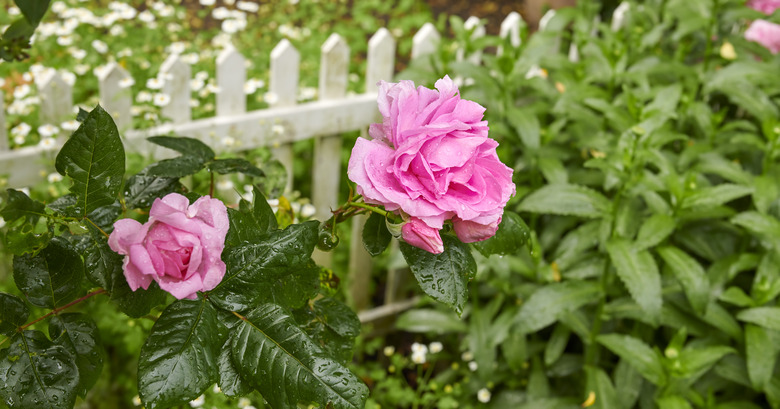How To Take Care Of A Mini Rose Plant
We may receive a commission on purchases made from links.
Do you love roses (Rosa spp.) but don't have space to grow a rose bush or climbing roses? A mini rose plant shrinks down the full-size plant into a compact rose bush that typically grows between 1 and 3 feet high and up to 2 feet wide. Mini roses grow in the ground or in containers, and they usually require care that is similar to their full-size counterparts.
Choose a Sunny Spot
Choose a Sunny Spot
Mini roses love direct sunlight, so find a sunny spot for your plant whether you plant it on the ground or keep it in a container. While mini roses usually grow best outdoors, you can grow them in a pot indoors if it receives enough sunlight. A south-facing or west-facing window is usually best when you grow the plant indoors. Rotate the container at least once per week so all sides of the mini rose receive direct sunlight to help the plant grow evenly.
If you keep your mini rose indoors in the winter and want to move it outdoors in the summer, make the move gradually. Wait until May when the weather is warm and sunny. Acclimate the mini rose to outdoor life by placing the pot in a shady spot. Over the course of several days, gradually increase how much sunlight the rose gets until it's ready for full sun.
Use the Right Soil
Use the Right Soil
If you keep your mini roses in containers, use well-draining potting soil for optimal growth. Mini roses prefer slightly acidic soil with a soil pH between 6.5 and 7.5. Soil should be loose and well-draining for outdoor growing. When planting mini roses on the ground, leave at least 12 inches between the holes. Larger mini rose bushes with a wider spread should be spaced further apart to leave enough room for the mature growth.
Water Mini Rose Plants Deeply
Water Mini Rose Plants Deeply
Adequate water keeps your mini rose plant growing well. A general guideline is ensuring that your mini roses get at least 1 inch of water every week between rain and your supplemental irrigation. In hot, dry conditions, the plants might need more. When the soil feels dry to the touch, water the plant. Roses do best when they are watered in the morning so the plants can dry, reducing the risk of fungal diseases.
If you keep your mini rose in a container, you'll likely need to water it more often. The limited amount of soil dries out quickly. Water the mini rose until water comes out of the drainage holes. Dump out the extra water from the tray to keep the roots from becoming too wet.
Prune Mini Roses Occasionally
Prune Mini Roses Occasionally
Mini roses stay small naturally, so they don't need to be pruned for size. However, a type of pruning called deadheading can help encourage your mini rose to produce more flowers. Deadheading involves removing the spent flowers so the bush produces more. Use pruning shears to cut off the dying blooms above the highest leaf.
Watch for Pests
Watch for Pests
Your miniature rose is susceptible to some of the same pests as larger roses, including spider mites. They create fine webs on the roses and sometimes cause discolored leaves. Aphids are tiny bugs that often group together on roses in colonies and weaken the plant by sucking its sap. Insecticidal soap can help control spider mites and aphids. You might need to apply the insecticidal soap multiple times to get rid of the infestation completely; observe the label directions for reapplication intervals.
Mini Rose Winter Protection
Mini Rose Winter Protection
If you grow your mini roses in pots, you can bring them indoors for the winter months. If they're planted on the ground, a little extra protection for cold temperatures can help the mini roses survive the winter and bloom in the spring. Use compost or soil to cover a large portion of the plant. A mound of 8 to 10 inches of soil around the mini rose provides it with winter protection, but be sure to rake the soil back when the weather warms in spring.
